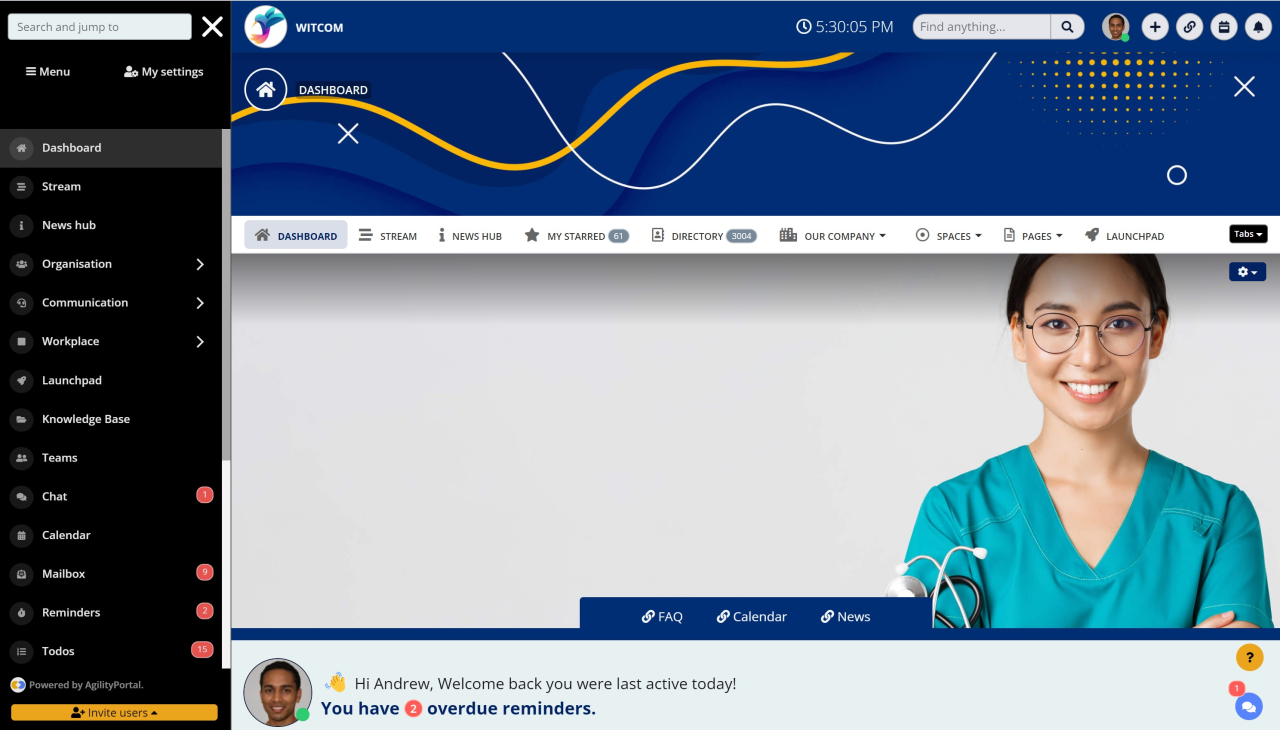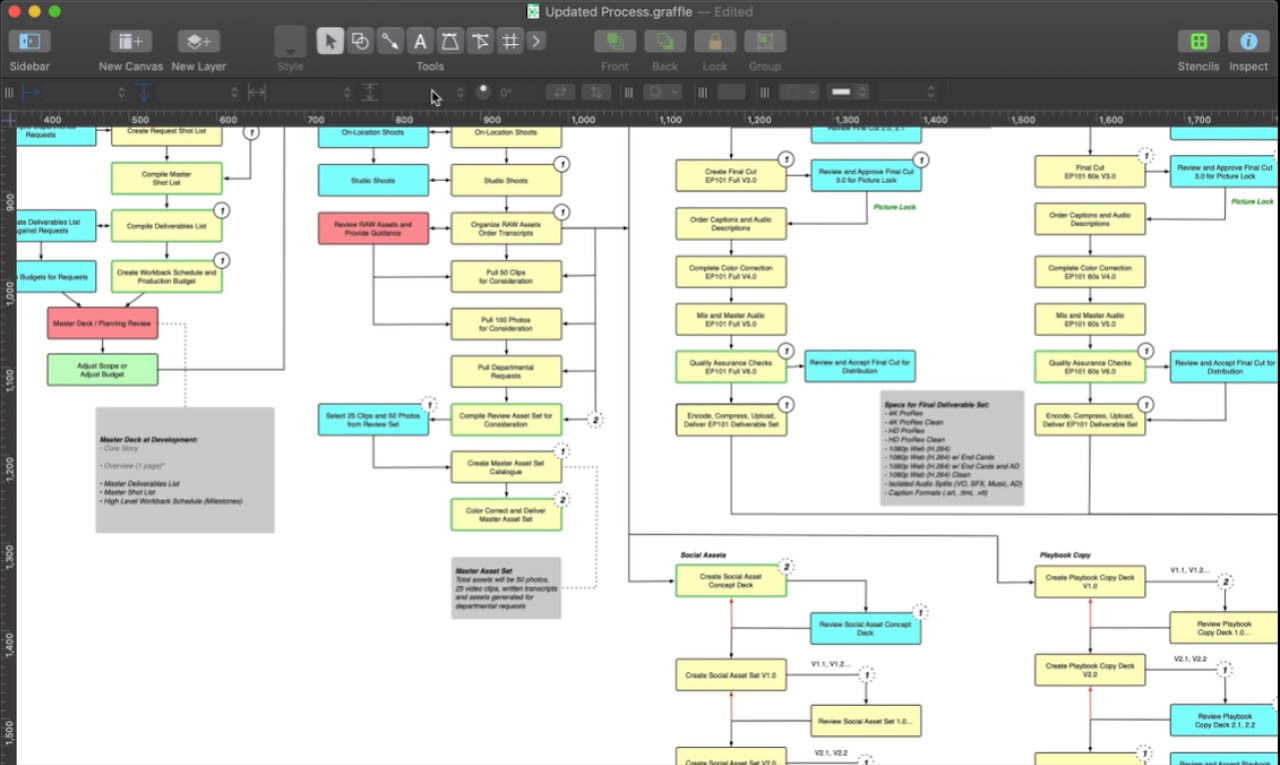Insight Blog
Agility’s perspectives on transforming the employee's experience throughout remote transformation using connected enterprise tools.
12 minutes reading time
(2333 words)
A Complete Guide To Intranet Sitemaps – Templates, Examples & More!
A site map serves as a blueprint that outlines the overall structure of your intranet site. Here is a Complete Guide To Intranet Sitemaps – Templates, Examples & More!
Once you've carefully defined your intranet goals, identified the relevant intranet content, and meticulously determined its optimal organization, it's time to delve into the crucial next step: constructing a robust Information Architecture for your intranet.
Information Architecture is the backbone of an effective intranet. It involves creating a well-thought-out structure that ensures seamless navigation, easy access to information, and an intuitive user experience.
Information Architecture is the backbone of an effective intranet. It involves creating a well-thought-out structure that ensures seamless navigation, easy access to information, and an intuitive user experience.
A solid Information Architecture lays the groundwork for an intranet that boosts productivity, enhances communication, and fosters collaboration among employees.
Intranet SiteMap
A site map serves as a blueprint that outlines the overall structure of your intranet site.
To initiate the site mapping process, assemble a small group of internal stakeholders and equip yourselves with a whiteboard. Ensure the group consists of employees from diverse departments or the intranet steering group.
The primary objective is for these stakeholders to identify the crucial parent or main pages of the intranet, along with their corresponding child or sub-pages.
Let's take the example of the Human Resources (HR) department to illustrate how to create a site map. The HR department will have a parent page, serving as the gateway to all HR-related information and data.
Child pages may include sections for vacation requests, performance management, wellness initiatives, employee benefits, and more.
Repeat this process for other departments and any centralized data that all staff members need to access.
If your site navigation follows a topic or task-based approach, stakeholders should determine clear section labels.
It's essential for the site map to align with the organization's context and structure. Ideally, users should be able to access critical information without the need for extensive searching. Moreover, each parent and child page should aim to address specific business problems or pain points.
Typically, parent pages are displayed as mega-menus in the intranet site architecture. These mega-menus offer dropdown access to lower-level child pages.
However, it's vital not to overwhelm the navigation with an excessive number of child pages. The goal is to maintain an intuitive and straightforward navigation system to ensure a pleasant user experience, avoiding the frustration of complicated automated phone systems.
Keep in mind that numerous content pieces will be shared across all teams. Common menus, overarching news items, and CEO messages often foster a sense of unity and cohesion among the workforce.
Building your intranet sitemap from the bottom up
Based on the results obtained from the card sorting exercise and the content inventory, you can initiate the construction of your lowest level groups. The card sorting exercise would have provided you with insights into the following:
- Content that users consistently group within a specific category.
- Content that users never group together.
- Content that is grouped in one category by some users and another category by other users.
Additionally, you would have gained knowledge of common category names used by users to describe the groupings. From the content inventory, you'll have information on the following:
- High-priority and frequently used content.
- How the content has been historically organized, aiding in understanding people's past grouping patterns.
- The breadth of content that needs accommodation within your structure.
You can also leverage other sources to assist in determining how to group content effectively. For instance, your public-facing website may have different content, but it can provide valuable insights into how products or services are organized.
Similarly, exploring how-to guides or manuals can offer ideas on organizing content based on specific tasks.
A glance at their table of contents can help you determine if those groupings can be applied to the intranet.
With the lower level groups in place, you can then proceed to combine them into higher-level groupings and continue this process iteratively.
Intranet Sitemap Generators
Keep in mind that software and tools can evolve, so it's essential to check for the latest options and reviews.
Here are some of the best Intranet sitemap generators:
- Slickplan - Slickplan is a popular sitemap and flowchart generator that offers an intuitive interface and a range of features suitable for Intranet sitemaps. It allows you to create visual sitemaps quickly and collaborate with team members.
- DYNO Mapper - This tool provides comprehensive sitemap and content planning functionalities, making it suitable for Intranets of various sizes. It also includes content inventory and auditing features, helping you better understand your content structure.
- MindMeister - While primarily known as a mind mapping tool, MindMeister can also be used to create sitemaps. It's ideal for small to medium-sized Intranets and offers a simple interface for collaborative sitemap creation.
- Lucidchart - Another versatile tool, Lucidchart, allows you to create sitemaps, flowcharts, and various visualizations. Its drag-and-drop functionality makes it easy to build Intranet sitemaps with different levels of hierarchy.
- GlooMaps - GlooMaps is a straightforward and user-friendly sitemap generator designed to create visual sitemaps with ease. It's suitable for smaller Intranet projects and offers basic collaboration features.
- WriteMaps - This tool provides a simple and effective way to create sitemaps for Intranets. It allows you to create, edit, and share sitemaps with your team for collaborative feedback.
- XML-Sitemaps - While primarily used for website sitemaps, XML-Sitemaps can be helpful for smaller Intranet projects as well. It crawls your site and generates XML and HTML sitemaps.
- PowerMapper - PowerMapper offers a suite of website and Intranet mapping tools, including visual sitemaps and content inventory reports. It's suitable for larger and more complex Intranet projects.
Remember to review each tool's features, pricing, and user reviews to find the one that best fits your specific requirements and budget.
As technology evolves, new Intranet sitemap generators may have emerged, so consider exploring recent reviews and comparisons to find the latest and most suitable option for your needs.
Follow us and access great exclusive content everyday: Follow us on Google News
How to Building your intranet sitemap from the top up
As you work on structuring the content within AgilityPortal, consider creating lower-level groupings while also envisioning your top-level categories. These top-level categories serve as the primary organizational pillars for all the content on your intranet site.
They will be prominently displayed in the navigation bar, providing easy access to essential information.
To design effective top-level categories, it's beneficial to follow best practices and observe successful patterns utilized in other intranets. The insights gained from your card sorting exercise can also inform your decision-making process.
Furthermore, ensure that you align your new structure with the goals set for AgilityPortal. B
y referencing these objectives, such as improving the efficiency of front-line staff, you can prioritize and showcase the content that caters to their needs. This approach will contribute to a more purposeful and user-centric intranet experience.
More on Intranet Information Architecture
Your company's intranet will encompass an extensive repository of valuable information. To ensure optimal usability, top-notch intranets prioritize organizing this wealth of data in a logical manner, making it easily accessible.
The significance of Intranet Information Architecture (IA) cannot be overstated, as it plays a pivotal role in the intranet's success.
IA primarily focuses on enhancing the findability and discoverability of the intranet's content, thus elevating the overall user experience.
Intranet Design Best Practices
Now is the moment to enhance the design of your new intranet.
We will explore essential considerations and key points you should bear in mind.
Within this chapter, we delve into the realm of best practice intranet design. Our focus is on discussing the latest trends and guidelines that will steer the design of your intranet.
Having been in existence since the 1990s, intranets offer a wealth of evidence from best practices, which this guide utilizes.
For more in-depth tips and advice on intranet design, you can refer to our blog. However, here, we provide an overview of the primary issues to consider.
Intranet Sitemap Templates To Get Started
Here's a basic Intranet sitemap template to help you get started. The sitemap outlines the main sections and pages of the Intranet site:
1. Home
- Welcome Message
- Latest News
- Important Announcements
2. About Us
- Company Overview
- Mission and Vision
- Organizational Structure
- Our Values
3. Departments
- Human Resources
- Job Openings
- Employee Benefits
- Training and Development
- IT Services
- Software Downloads
- IT Helpdesk
- Network Guidelines
- Finance
- Budget Reports
- Expense Policies
- Invoices and Payments
4. Employee Resources
- Policies and Procedures
- Employee Handbook
- Forms and Templates
- Holidays and Leave
- Health and Wellness
5. Communication
- Internal Newsletters
- Events and Activities
- Employee Recognition
- Employee Surveys
6. Knowledge Base
- FAQs
- How-to Guides
- Troubleshooting
- Best Practices
7. Collaboration Tools
- Document Management
- Team Calendars
- Project Management
- Discussion Forums
8. Contact Us
- General Inquiries
- Department Contacts
- Feedback and Suggestions
1. Home
- Welcome Message
- Latest News
- Important Announcements
2. About Us
- Company Overview
- Mission and Vision
- Organizational Structure
- Our Values
3. Departments
- Human Resources
- Job Openings
- Employee Benefits
- Training and Development
- IT Services
- Software Downloads
- IT Helpdesk
- Network Guidelines
- Finance
- Budget Reports
- Expense Policies
- Invoices and Payments
4. Employee Resources
- Policies and Procedures
- Employee Handbook
- Forms and Templates
- Holidays and Leave
- Health and Wellness
5. Communication
- Internal Newsletters
- Events and Activities
- Employee Recognition
- Employee Surveys
6. Knowledge Base
- FAQs
- How-to Guides
- Troubleshooting
- Best Practices
7. Collaboration Tools
- Document Management
- Team Calendars
- Project Management
- Discussion Forums
8. Contact Us
- General Inquiries
- Department Contacts
- Feedback and Suggestions
The structure and content will vary based on the specific needs and size of your organization. As you develop your Intranet, consider the usability and navigation to ensure that employees can easily find the information they need.
You may also like: Best Apps for Employees: UPDATED 2022 – A Complete Guide
Thing to consider an intranet sitemap
- Limit the top navigation to fewer than ten categories to prevent overwhelming users with too many options.
- Keep category names concise while retaining their meaning, ensuring grammatical consistency.
- Avoid generic labels like "Other" or "Misc." to prevent them from becoming catch-all sections for hard-to-categorize content.
- Avoid structuring your Information Architecture (IA) solely based on your organization's internal structure, as it may require users to know the content owners.
- In cases where different groups in your organization use distinct categories to group content, designate one primary category for the content and provide links from other categories back to the content in the primary category. This ensures that users navigating through secondary content can still find what they need in the primary category.
- Keep in mind that these are guidelines and not strict rules, allowing for exceptions when necessary.
Benefits of Sitemap Templates
The Importance of Creating a Website Structure Template: 3 Key Benefits
Investing time in developing a website structure template can significantly impact your web development process in three crucial ways:
1. Facilitating Stakeholder Collaboration
A well-designed sitemap serves as a powerful tool to enhance collaboration with stakeholders. By visually representing the intricate components of the website, it becomes easier for all parties involved to understand and contribute effectively. Productive working sessions are encouraged, as the sitemap provides a clear and concise overview of the website's structure, fostering valuable discussions and alignment among team members.
2. Streamlining Information Sharing
Using a sitemap template simplifies the process of sharing essential information about the website under construction. Instead of relying on lengthy emails or meetings, a mere sketch on the sitemap conveys the necessary details. This efficient method ensures that communication is clear and concise, reducing the risk of misunderstandings and saving valuable time for everyone involved.
3. Optimizing Resource Management
Building and maintaining a website can be resource-intensive, especially if you frequently make substantial changes or start from scratch. With a website sitemap template in place, you gain a controlled environment to test and iterate ideas. This empowers you to take calculated risks, explore various possibilities, and evaluate their effectiveness without directly impacting the live site. By doing so, you conserve time and resources, ensuring that your website evolves in a more efficient and cost-effective manner.
Sharepoint Online Sitemaps – All You Should Know
SharePoint Online is a powerful collaboration and document management platform provided by Microsoft as part of the Office 365 suite.
One essential aspect of SharePoint Online is its sitemap, a hierarchical representation of the site's structure, which plays a crucial role in navigation, search engine optimization, and content discoverability.
Here's everything you should know about SharePoint Online sitemaps.
- Definition and Purpose - A SharePoint Online sitemap is a dynamic XML file that outlines the structure of a site and its subsites, including lists, libraries, pages, and other content. It serves as a roadmap for both users and search engines to navigate the SharePoint site efficiently. The sitemap also facilitates search engines in indexing content, enhancing the site's visibility in search results.
- Automatic Generation - SharePoint Online automatically generates the sitemap for each site and keeps it updated as changes occur in the site's structure. It ensures that new content is promptly indexed and available for search engines to crawl.
- Site Navigation - The sitemap enables users to navigate the SharePoint site easily. It provides a clear hierarchical view of the site's structure, allowing users to access different sections and content with ease.
- SEO Benefits - Search Engine Optimization (SEO) is crucial for improving the visibility of a website in search engine results. SharePoint Online's sitemap aids in SEO efforts by allowing search engines to crawl and index the site efficiently, thereby increasing the chances of better rankings.
- Search Functionality - SharePoint Online's search functionality utilizes the sitemap to display relevant results to users. When a user searches for content, the sitemap helps the search engine identify the most appropriate pages to display in the results.
- Customization and Configuration - While SharePoint Online automatically generates sitemaps, administrators can customize and configure sitemap settings to meet specific requirements. This includes deciding which content to include in the sitemap and setting the frequency of sitemap updates.
- Public and Private Sites - SharePoint Online supports both public-facing and private/internal sites. For public sites, the sitemap aids in making content accessible to search engines. In contrast, for private sites, it helps users within the organization find information more efficiently.
In conclusion, SharePoint Online sitemaps are essential components of an effective SharePoint site.
They enable smooth navigation, boost SEO efforts, and facilitate content discoverability for both users and search engines.
Understanding and utilizing SharePoint Online sitemaps can significantly enhance the overall user experience and the site's online visibility.
Free ebook: How To Get Your Intranet Off The Ground
Categories
Blog
(2612)
Business Management
(323)
Employee Engagement
(212)
Digital Transformation
(174)
Growth
(119)
Intranets
(113)
Remote Work
(61)
Sales
(48)
Collaboration
(36)
Project management
(29)
Culture
(28)
Customer Experience
(26)
Knowledge Management
(21)
Leadership
(20)
Comparisons
(6)
News
(1)
Ready to learn more? 👍
One platform to optimize, manage and track all of your teams. Your new digital workplace is a click away. 🚀
Free for 14 days, no credit card required.














